|
Report
from
Europe
EU joinery sector flatlines
A single word describes the current state of the joinery
sector in Europe. That word is ¡°flat¡±. It¡¯s also a
reasonable description of the state of the European
economy as a whole. There are a few bright spots ¨C
notably the UK ¨C but not enough to offset slow demand
elsewhere.
Total GDP across the EU expanded by 0.3% in the third
quarter of 2014, only slightly better than 0.2% growth
recorded in the second quarter (Table 1). Growth in the
UK and Spain was good in Q3 2014.
France recovered sufficiently in Q3 2014 to avoid entering
a technical recession (usually defined by a fall in GDP in
two successive quarters). Germany also avoided this fate,
but just barely. Italy continued to decline.
Economic Sentiment in the EU was rising in the first half
of 2014 but falling in the second half of the year (Chart 1).
Construction confidence in Europe continued to rise to the
end of 2014 (Chart 2).
However this was mainly on the back of better
performance in the UK and Spain and overall sentiment is
still in negative territory (meaning that a majority of
construction companies still expect order books and
employment levels to fall in the next 3 months).
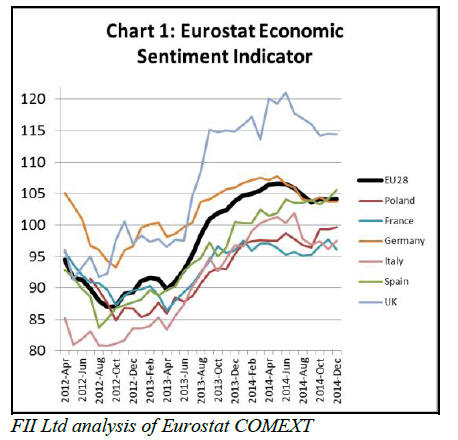 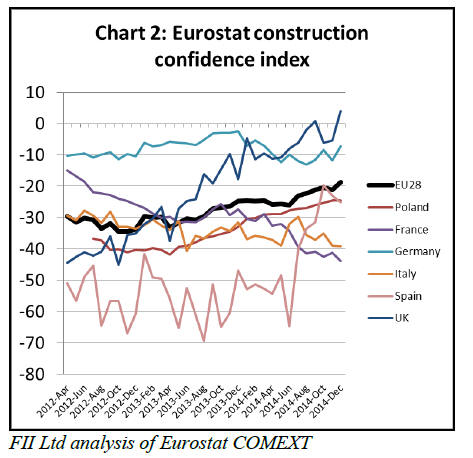
Having recovered a little in the second quarter of 2013,
EU construction production remained stubbornly stuck at
8% below the 2010 level at least until November 2014
(Chart 3).
Data on building permits is more encouraging. These
increased across the EU in the first quarter of 2014 and
remained at the higher level in the next 2 quarters (Chart
4).
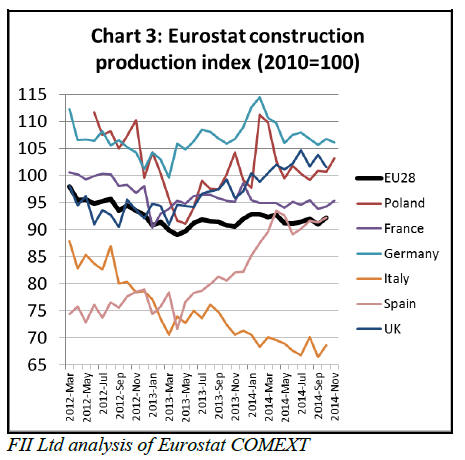 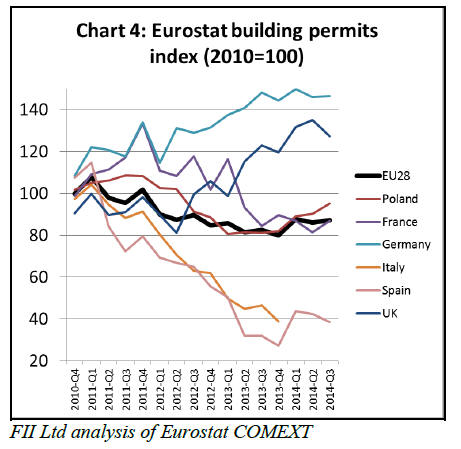
There follows more detailed consideration of construction
sector activity at national level in the EU. This draws on
results of the latest European Architects Barometer (EAB)
survey of 1,600 architects undertaken by Archi-Vision in
eight European countries for the third quarter of 2014.
Germany: there are clear signs of slowing growth in both
the national economy and construction sector. The EAB
survey showed only very slow growth in architect‟s order
books and turnover in Q3 2014. All three economic
confidence indicators (consumer, industrial and
construction) declined slightly in Germany during the
same period. Archi-Vision estimates German construction
grew 1% in 2014 and will grow at the same slow rate in
both 2015 and 2016.
UK: the construction sector continued to strengthen in the
second half of 2014 but at a slower pace than in the first
half. Building permits for both residential and nonresidential
construction in the UK are stable, although
some confidence indicators show a slight decrease.
The EAB indicates that UK architectural firms remained
positive in Q3 2014 with strong order books and
expectations of good turnover development. Archi-Vision
estimate that the UK construction market increased 3% in
2014 and will continue to grow at the same rate in 2015.
Growth is forecast to slow only slightly to 2% in 2016.
France: construction sector activity is contracting again.
The EAB indicates architects order books fell sharply in
Q3 2014. Archi-Vision estimates French construction
activity fell 2% in 2014 and will fall another 1% in 2015
before stabilising at the lower level in 2016.
Spain: while well down on pre-recession levels, the
construction market is slowly improving. The Eurostat
construction production index indicates significantly
higher levels of Spanish output in 2014 compared to the
previous year. According to EAB, architects order books
increased in each of the first three quarters of 2014.
However these positive figures do not align to the building
permit trend. Permits for residential construction in Spain
have been stable but there was a fall in non-residential
permits in the second and third quarters of 2014. In
contrast to Eurostat, Archi-Vision reckons that Spanish
construction fell around 4% in 2014. Archi-vision forecast
a further 1% contraction in 2015 and zero growth in 2016.
Italy: the construction market continues to slide and the
outlook remains very poor. The EAB indicates architects
order books were falling in the first three quarters of 2014.
In Q3 2014, 50% of Italian architects reported negative
developments in their order book and only 11% reported
positive developments.
Data on Italian building permits in 2014 has yet to be
published, but data for 2013 showed permits at only 40%
of the 2010 level. This will dampen construction activity
for several years. After declining 11% in 2013, Arch-
Vision estimates that Italy‟s construction market fell 7% in
2014 and will fall a further 4% in 2015 and 1% in 2016.
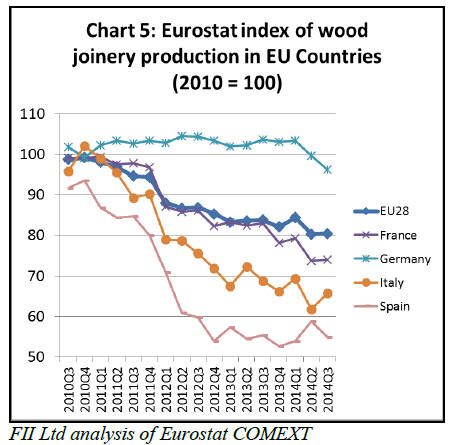
Netherlands: the construction market is recovering, but
only very slowly. The EAB survey indicates that architects
order books increased again in the third quarter of 2014,
continuing a rising trend which began in the second half of
2013.
Positive architectural sentiment is also reflected in other
economic indicators including consumer, industrial and
construction confidence.
The Eurostat construction production index indicates
activity remained flat at around 90% of the 2010 level
throughout 2014. Archi-Vision estimate that construction
activity in the Netherlands increased by 1% in 2014 and
that growth will pick up to 2% in 2015 and 3% in 2016.
Belgium: the market is slow but tending to rise overall.
However signals from various indicators of construction
activity are mixed. The Eurostat construction production
index shows rising activity between March 2013 and
March 2014, but then a slight decline in activity during the
rest of the year.
In contrast, EAB indicates a marginal improvement in
architects‟ order books in the second and third quarters of
2014.
The building permit figures also show contrasting
developments: a big fall for residential permits but a
steady increase for non-residential. Archi-Vision estimate
2% growth in Belgian construction activity in 2014 and
predict equivalent levels of growth in both 2015 and 2016.
Poland: construction market activity was only moderate in
2014 but is growing slowly. Unlike other large EU
economies, Poland‟s construction sector relies heavily on
new build which accounts for 73% of total volume.
Eurostat‟s construction production index for Poland
increased sharply between May 2013 and March 2014, but
then slipped in April 2014 before stabilising at a moderate
level for the rest of the year.
The EAB indicates architects order books improved in the
first half of 2014, but weakened a little in the third quarter
of the year.
The Eurostat construction confidence index for Poland
was rising throughout 2014, but still remains in negative
territory.
However there was good growth in building permits in the
first 3 quarters of 2014 suggesting better prospects in
2015. Archi-Vision estimate that construction activity
increased 2% in 2014 and forecast the same rate of growth
in 2015, rising to 3% in 2016.
No change in EU joinery production in third quarter of
2014
The Eurostat index of joinery production in EU countries
(which excludes flooring but includes doors, windows and
glulam) shows that production was stationary at around
80% of the 2010 level in both the second and third
quarters of 2014 (Chart 5). A slight upturn in production in
Italy and the UK was not sufficient to offset a decline in
Germany and Spain.
Downturn in European window and door market
forecast for 2015
According to an article in EUWID, the European timber
trade journal, the German building fittings producer Roto
Frank AG is forecasting a further downturn in European
window and door markets in 2015.
Roto Frank AG reports that the European window and
door market softened more than expected in 2014. A big
decline in sales in South and Eastern Europe more than
offset slightly higher sales in the UK, Germany and
Switzerland.
Roto Frank AG also reports that growth in window and
door consumption in Germany during 2014 was mainly
supplied by imports from other European countries,
notably Poland.
In 2014, Poland‟s output of windows and doors jumped
sharply despite a fall in the domestic market. As a result
more Polish-made products are now being exported to
other European countries.
Sales by German manufacturers in 2014 were around 6-8
% lower than the previous year. Manufacturers in France
and Italy also posted sharp falls in sales in 2014, while the
Spanish market has stabilised.
With the exception of the UK, Roto Frank AG expects the
European market to stagnate in 2015. The slump in Russia
and Ukraine is expected to intensify.
European joinery product import trends
As noted in previous reports, imports make up only a very
small component of EU consumption of joinery products.
In 2013, only €275 million (4.5%) of the €6.06 billion of
wooden doors supplied to the EU were imported. In the
case of wood windows, €23 million (0.4%) of the €5.96
billion supplied were imported. In 2013, glulam imports
were 112,000 m3, only 4% of the 2.76 million m3
supplied to the EU.
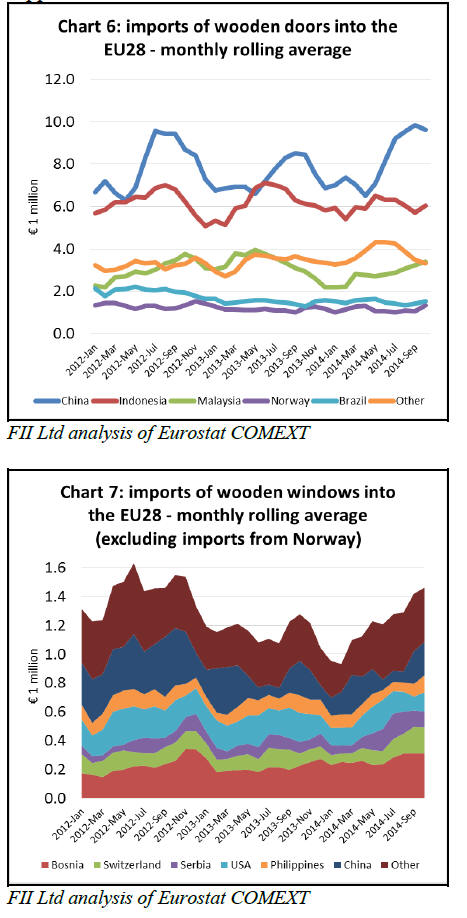
The monthly trend in wooden door imports into the EU
from leading supply countries during the 2012-2014
period is shown in Chart 6. Imports from China, the
largest external supplier to the region, have been volatile
but generally rising during this period.
There was a particularly sharp increase in EU wooden
door imports from China between April 2014 and October
2014. The EU imported doors from China with a total
value of €10 million in both October and November 2014,
the highest level for several years.
EU imports of wood doors from Indonesia, now the
second largest external supply country, have consistently
averaged €6 million per month during the last three years.
Imports from other supply countries have remained
relatively stable at a low level over the same period.
The small quantity of finished wood windows imported
into the EU derive mainly from other European countries
(Chart 7). This highlights the importance of proximity to
the customer in the wood window sector.
Total EU imports of wood windows, which rarely exceed
€1.4 million per month, were rising at the end of 2014,
mainly from Bosnia and Switzerland.
Imports from China are very limited and have declined in
recent years. Most of the small volume of wood windows
imported into the EU from the tropics are from the
Philippines.
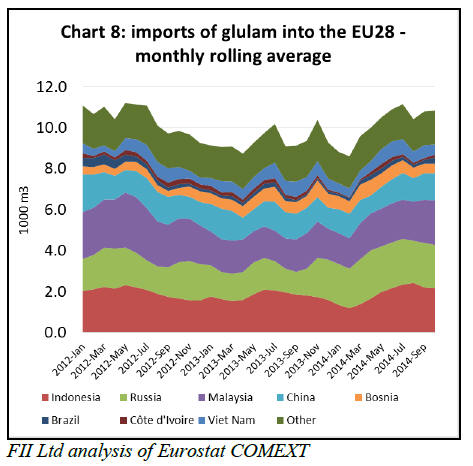
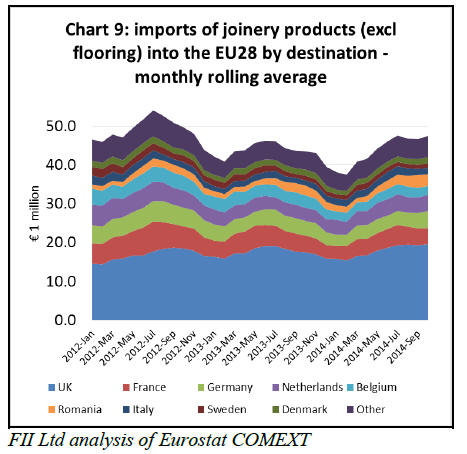
In line with the overall trend in the joinery sector, EU
imports of glulam have remained flat over the last three
years, averaging around 10000 m3 per month (Chart 8).
Much of this product comprises relatively small dimension
glulam for window frames. There was a slight increase in
imports of meranti scantling from Indonesia and Malaysia,
and of Siberian larch scantlings from Russia and China in
the second half of 2014.
Chart 9 shows that much of the recent growth in EU
imports of joinery products from outside the region is
destined for the UK, which alone accounts for around 40%
of all import value.
Of other EU import markets, only Romania showed signs
of growth during 2014. Imports from outside the EU into
France, Belgium, Germany, and the Netherlands were
either stable or slightly declining.
* The market information above has been generously provided by the
Chinese Forest Products Index Mechanism (FPI)
|